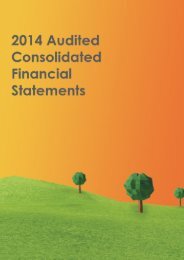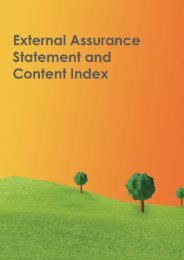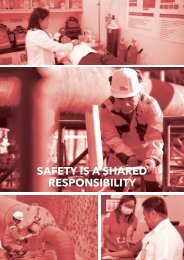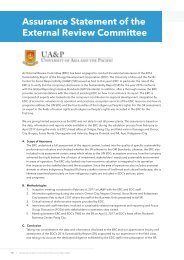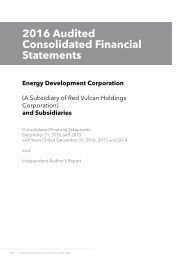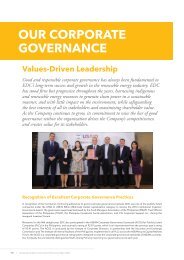EDC 2014 SR (UPDATED)
Create successful ePaper yourself
Turn your PDF publications into a flip-book with our unique Google optimized e-Paper software.
<strong>EDC</strong> <strong>2014</strong> Performance Report<br />
Cash and Cash Equivalents<br />
Cash and cash equivalents in the consolidated statement of financial position comprise cash in<br />
banks and on hand and short-term deposits with original maturities of three months or less from<br />
dates of acquisition and that are subject to insignificant risk of changes in value.<br />
Parts and Supplies Inventories<br />
Inventories are valued at the lower of cost and net realizable value. Cost includes the invoice<br />
amount, net of trade and cash discounts. Cost is calculated using the moving average method.<br />
Net realizable value represents the current replacement cost.<br />
Prepaid Expenses<br />
Prepayments are expenses paid in advance and recorded as asset before these are utilized. This<br />
account comprises prepaid expenses, creditable withholding tax, tax credit certificates and<br />
advances to contractors. The prepaid expenses are apportioned over the period covered by the<br />
payment and charged to the appropriate accounts in the consolidated statement of income when<br />
incurred; creditable withholding tax are deducted from income tax payable on the same year the<br />
revenue was recognized; and the advances to contractors are reclassified to the proper asset or<br />
expense account and deducted from the contractor’s billings as specified on the provision of the<br />
contract. Prepayments that are expected to be realized for a period of no more than 12 months<br />
after the financial reporting period are classified as current asset; otherwise, these are classified as<br />
other noncurrent asset.<br />
Property, Plant and Equipment<br />
Property, plant and equipment, except land, is stated at cost less accumulated depreciation,<br />
amortization and impairment in value, if any. The initial cost of property, plant and equipment,<br />
consists of its purchase price and any directly attributable costs of bringing the asset to its working<br />
condition and location for its intended use and any estimated cost of dismantling and removing the<br />
property, plant and equipment item and restoring the site on which it is located to the extent that<br />
the Company had recognized the obligation to that cost. Such cost includes the cost of replacing<br />
part of the property, plant and equipment if the recognition criteria are met. When significant<br />
parts of property, plant and equipment are required to be replaced in intervals, the Company<br />
recognizes such parts as individual assets with specific useful lives, depreciation and amortization.<br />
All other repairs and maintenance costs are recognized in the consolidated statement of income as<br />
incurred. Land is carried at cost less accumulated impairment losses, if any.<br />
The income generated wholly and necessarily as a result of the process of bringing the asset into<br />
the location and condition for its intended use (e.g., net proceeds from selling any items produced<br />
while testing whether the asset is functioning properly) is credited to the cost of asset up to the<br />
extent of cost of testing capitalized during the testing period. Any excess of net proceeds over<br />
costs is recognized in profit or loss. When the incidental operations are not necessary to bring an<br />
item to the location and condition necessary for it to be capable of operating in the manner<br />
intended by management, the income and related expenses of incidental operations are not offset<br />
against the cost of the asset but are recognized in profit or loss and included in their respective<br />
classifications of income and expense.<br />
164




